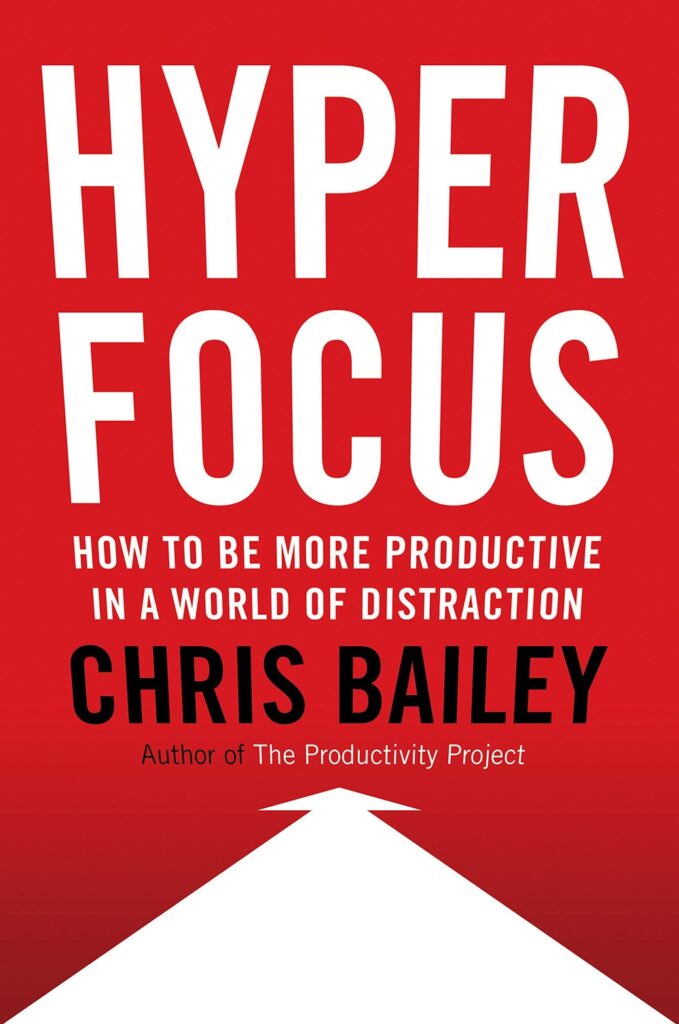Sharing my learnings from the book, Hyperfocus by Chris Bailey
Hyperfocus by Chris Bailey
Our attention has never been as overwhelmed as it is today. Many of us recognize that our brains struggle to multitask. Despite this, we feel compelled to do so anyway while we fill each moment of our lives to the brim with mindless distraction. Hyperfocus provides profound insights into how you can best take charge of your attention to achieve a greater sense of purpose and productivity throughout the day.

- Think back to the last time you had an unusually productive day at work – when you were on your A game, getting things done with uncharacteristic ease? Instead of seeming like a chore, your work becomes compelling – meaning that every time you look at the clock, another hour has passed. When you’re in that mood, your mind’s engaged, undistracted, and incisive; in other words, you’re hyperfocused.
- For a start, you tend to give one single task your sustained attention. You don’t multitask. Rather than working frantically and jumping from one job to another, you focus your attention on one thing, and you keep it there until the task is finished.
- You also avoid all distractions
- It’s useful to think about your attention as a small, circumscribed area that can easily be filled – a kind of attentional space. Given the size of this space, it makes sense to carefully control what goes into it.
- Meta-awareness refers to the ability to step outside your thoughts, and become aware of what you’re thinking.
- meta-awareness and intentions go hand in hand. Meta-awareness acts as a reminder to check in on your attentional space, intentions show you where to redirect your attention when you need to.
- Rather than trying to resist distractions in advance, save yourself the trouble and remove the risk ahead of time.
- scrutinize your environment and identify anything that’s more stimulating and appealing than the work you need to do.
- And if you find that you’re being derailed by irrelevant thoughts, pause for a minute and write down everything that’s on your mind.
- the act of putting distracting thoughts on paper helps to get them out of your head – freeing your attentional space for the task at hand.
- Hyperfocus is a powerful tool. The ability to give sustained, intense attention to whatever task you’re engaged in, gives you an edge in a wide variety of situations.
- hyperfocus alone isn’t enough. Your mind needs time to rest and refresh every now and then – and even more importantly, you need to give yourself the opportunity to be creative.
- When the situation calls for inventiveness and originality, then, you need to adopt a different approach: scatterfocus
- One of the main differences between scatterfocus and hyperfocus is time; where hyperfocus helps you to attend to tasks in the present, scatterfocus very often addresses the future.
- In order to get to grips with scatterfocus, it’s worth breaking it down into three specific types of thinking
- Capture mode is the most basic, and for many people, the most boring. It consists of taking stock of whatever’s on your mind.
- problem-crunching mode involves holding a single issue in your mind and letting your thoughts circle it, searching for new angles, ideas, and solutions.
- habitual mode comes into play whenever you perform a simple, repetitive task, which engages part of your attention but still leaves ample space for reflection.
- One of the reasons that scatterfocus can lead to novel ideas and creative breakthroughs is because of something called the Zeigarnik Effect. In short, this describes the brain’s tendency to brood on works in progress rather than on completed tasks. You mull over present problems, not long-resolved ones.
- Make a habit of writing out any problems you’re trying to solve and review the list regularly. Reading over it’ll help keep your concerns at the forefront of your mind, in close contact with new thoughts and experiences.
- Nourish your mind to make the most of scatterfocus.
- One good strategy is to discover more about your area of interest and create a constellation of related dots in your mind.
- be careful not to allow a single subject to monopolize your attention. The beauty of scatterfocus is, after all, the way it combines diverse types of information.
- What’s most important is that the informational dots you consume are high-quality, whatever their domain.
- One way to get more selective about the information you consume is to consider every option as a bid for your attention.
- you should ensure that what you read, watch, and listen to possess real intellectual value.


Leave a Reply